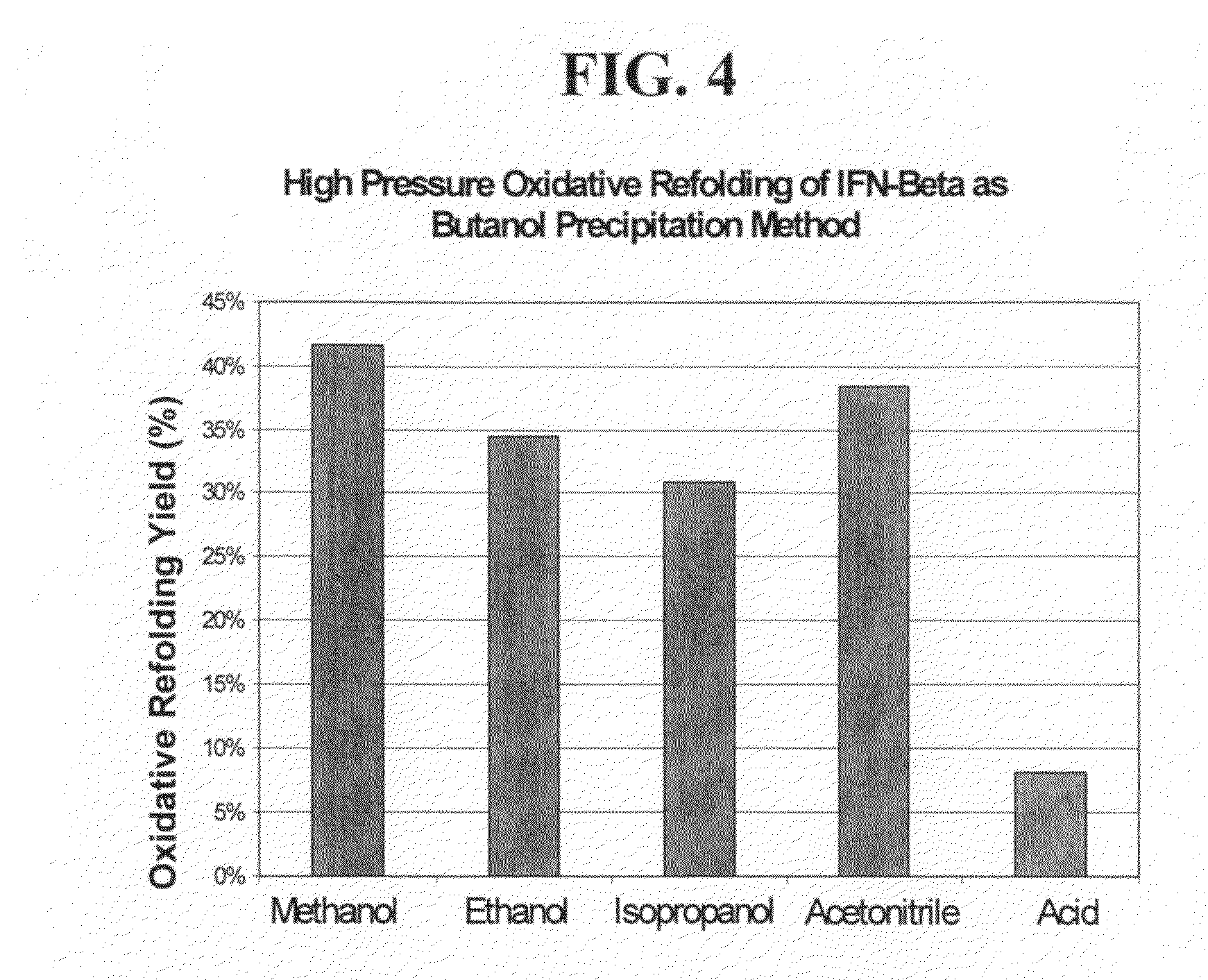High pressure treatment of aggregated interferons
a high pressure treatment and interferon technology, applied in the field of recombinant human interferons, can solve the problems of protein aggregation, non-native protein inclusion bodies, and large aggregation, and achieve the effects of improving the refolding yield of high pressure treatment, high resistance to disaggregation and refolding, and enhancing the effect of high pressure treatmen
- Summary
- Abstract
- Description
- Claims
- Application Information
AI Technical Summary
Benefits of technology
Problems solved by technology
Method used
Image
Examples
example 1
[0210]Experiments were conducted to express C17S IFN-beta-1b in E. coli.
Construction of C17S IFN-Beta Gene Sequence
[0211]The C17S protein sequence for IFN-beta (according to SEQ ID No. 2 and shown in FIG. 1) was expressed in E. coli.
[0212]The gene for Interferon-beta (IFN-β) was isolated by PCR amplification of human genomic DNA (Cat. # 636401, Clontech, CA), using primers BARO 1 (5′CACGTGCATATGAGCTACAACTTGCTTGGATTC) and BARO 4 (5′CGGAATTCTTAGTTTCGGAGGTAACCTGTAAG). The resulting fragment was digested with restriction enzymes NdeI (recognition sequence CATATG) and EcoRI (recognition sequence GAATTC), and cloned into similarly digested and calf intestine alkaline phosphatase (CIP)-treated pUC19. Several clones were isolated and sequenced, and one clone with the correct sequence was subjected to PCR-based mutagenesis using forward primer BARO 8 (5′AGCAGCAATTTTCAGTCTCAGAAGCTTCTGTGGCAATTG) and reverse primer BARO 9 (5′CAATTGCCACAGAAGCTTCTGAGACTGAAAATTGCTGCT) as described in Higuchi R. ...
example 2
[0218]The effect of “traditional” refolding conditions on the refolding of IFN-beta from inclusion bodies were examined.
[0219]Washed inclusion bodies of IFN-beta were obtained as described below. U.S. Pat. Nos. 7,064,192 and 6,489,450 teach the skilled artisan the general methods for refolding protein aggregates using high pressure (Randolph, Carpenter et al. 1999). Of these methods, 2000 bar treatment at a temperature of 25° C., for sixteen hours, at a refolding pH of 8.0, in the presence of 4 mM reduced glutathione (GSH) and 2 mM oxidized glutathione (GSSG) has been used for the refolding of proteins that contain disulfide bonds such as hen egg white lysozyme, placental bikunin, and malaria pfs48 (St. John, Carpenter et al. 2002; Seefeldt, Ouyang et al. 2004; Seefeldt 2005; Lee, Carpenter et al. 2006). In line with those earlier experiments, inclusion bodies of IFN-beta were pressure treated at 2000 bar for sixteen hours at 25° C. in aqueous solutions conditions containing 50 mM T...
example 3
[0228]This example provided improved refolding of IFN-beta from inclusion bodies.
[0229]A series of experiments were conducted to examine the effect of pH, redox chemistry, refolding pressure, and detergent effects on the refolding if IFN-beta. After screening studies were conducted, the preferred refolding conditions were found to be incubation at 3500 bar, 50 mM CAPS (pH 10), 1.3 mM cysteine, 0.3 mM cystine, 0.05% Zwittergent 3-14 surfactant for 16 hours at 25° C. Depressurization was conducted at a rate of 250 bar / five minutes. Refolding yields of 44%+ / −2% were obtained, as based on RP-HPLC (see the methods described in Example 2).
[0230]Refolding in “preferred conditions” was compared to “typical” conditions that are taught in the prior art (2000 bar, pH 8, 4 mM GSH and 2 mM GSSG, 16 hours, 25° C., 250 bar / 5 minute depressurization) and were found to significantly improve the refolding of IFN-beta in comparison to prior methods, with yields of 44%+ / 2% and 0% respectively as analyz...
PUM
| Property | Measurement | Unit |
|---|---|---|
| weight percent | aaaaa | aaaaa |
| weight percent | aaaaa | aaaaa |
| weight percent | aaaaa | aaaaa |
Abstract
Description
Claims
Application Information
 Login to View More
Login to View More - R&D
- Intellectual Property
- Life Sciences
- Materials
- Tech Scout
- Unparalleled Data Quality
- Higher Quality Content
- 60% Fewer Hallucinations
Browse by: Latest US Patents, China's latest patents, Technical Efficacy Thesaurus, Application Domain, Technology Topic, Popular Technical Reports.
© 2025 PatSnap. All rights reserved.Legal|Privacy policy|Modern Slavery Act Transparency Statement|Sitemap|About US| Contact US: help@patsnap.com



